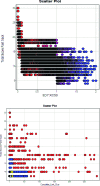An Invitation to Open Innovation in Malaria Drug Discovery: 47 Quality Starting Points from the TCAMS
- PMID: 24900261
- PMCID: PMC4018116
- DOI: 10.1021/ml200135p
An Invitation to Open Innovation in Malaria Drug Discovery: 47 Quality Starting Points from the TCAMS
Abstract
In 2010, GlaxoSmithKline published the structures of 13533 chemical starting points for antimalarial lead identification. By using an agglomerative structural clustering technique followed by computational filters such as antimalarial activity, physicochemical properties, and dissimilarity to known antimalarial structures, we have identified 47 starting points for lead optimization. Their structures are provided. We invite potential collaborators to work with us to discover new clinical candidates.
Keywords: Malaria; TCAMS; lead optimization; open innovation.
Figures






References
-
- World Health Organization. World malaria report; http://www.who.int/malaria/publications/atoz/9789241563901/en/index.htmlæ, 2009.
-
- Anstey N. M.; Russell B.; Yeo T. W.; Price R. N. The Pathophysiology of vivax Malaria. Trends Parasitol. 2009, 25, 220–227. - PubMed
-
- WHO. Global Report on Antimalarial Drug Efficacy and Drug Resistance: 2000–2010; WHO Press: Geneva, Switzerland, 2010.
LinkOut - more resources
Full Text Sources
Other Literature Sources

